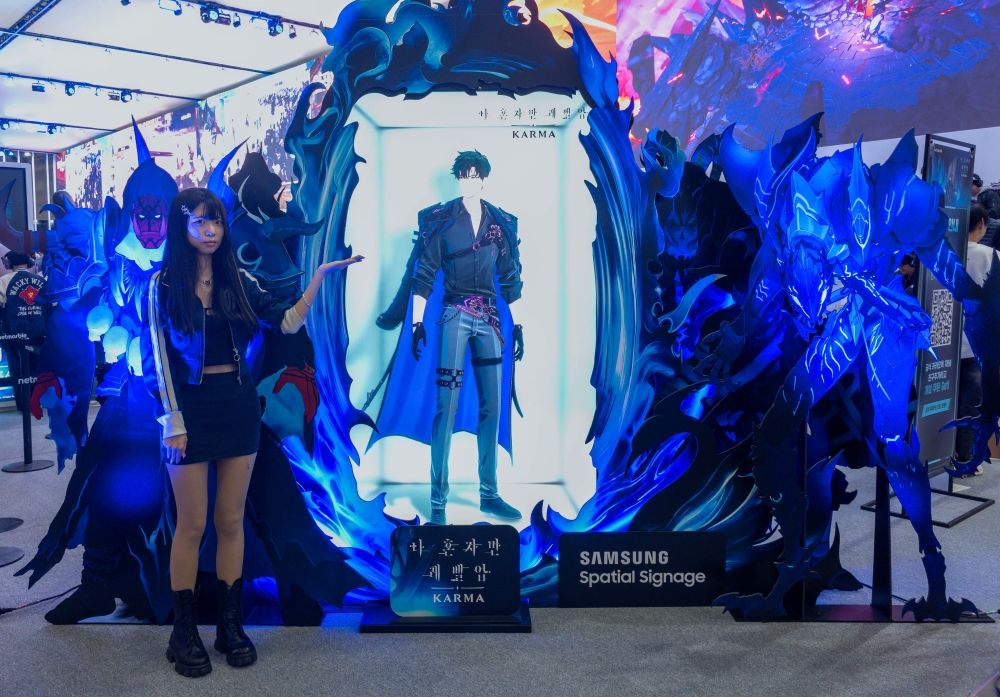Samsung just changed the game at G-Star 2025. The tech giant's new Spatial Signage technology brought game characters to life in glasses-free 3D, creating lines of visitors eager to interact with life-sized heroes from Solo Leveling and other popular titles. This breakthrough signals a major shift from flat screens to truly immersive display experiences.
Samsung turned heads at Korea's biggest gaming exhibition this week, but not for the reasons you'd expect. While thousands descended on G-Star 2025 expecting the usual gaming hardware demos, they instead found themselves face-to-face with their favorite characters in stunning 3D - no glasses required. The company's new Spatial Signage technology transformed Netmarble's booth into what visitors described as a portal between the physical and virtual worlds. Characters from Solo Leveling: KARMA literally appeared to step out of their screens, creating such long lines that organizers had to manage crowd control. "I usually play games on a monitor, so seeing the characters on such a large screen felt completely different," visitor Lee Sun-jae told Samsung's press team. "It really felt like facing the game characters in real life." This wasn't Samsung's first rodeo with 3D gaming displays. The partnership with Netmarble builds on collaborations at Gamescom 2025, Tokyo Game Show, and Brazil Game Show, where the companies have been fine-tuning audience reactions to glasses-free 3D experiences. But G-Star marked a breakthrough moment - the technology finally felt ready for mainstream adoption. Lee Jung-ho, Game Publishing Director at Netmarble, explained the evolution: "Since forming our 3D partnership with Samsung, we've worked together at multiple shows, closely monitoring user reactions. Using those insights, we've prepared a wide range of fresh and exciting content for G-Star 2025." The technical specs behind Spatial Signage sound almost too good to be true. At just 52mm thick, these displays create convincing 3D depth without the bulky hologram boxes that have dominated exhibition spaces for years. The secret lies in advanced parallax detection that optimizes depth perception for each viewer's position. "Traditional hologram devices are usually large, bulky, and old-fashioned in design," Lee Jung-ho noted during the exhibition. "Samsung's Spatial Signage isn't a hologram - it delivers true 3D visuals in an impressively slim form factor." But the real magic happened in Samsung's gaming zone, where visitors got hands-on time with the Odyssey 3D monitor (G90XF). This isn't just a display upgrade - it's a complete reimagining of how games should feel. Eye-tracking technology adjusts the 3D depth in real-time, while customizable settings optimize the experience for different game genres. Players testing MONGIL: STAR DIVE described feeling like they were "stepping directly into the game world" - a sensation that goes far beyond what traditional gaming monitors can deliver. The technology's impact extends beyond gaming. Samsung executives revealed plans to expand Spatial Signage into museums, educational centers, and retail environments. "This technology marks a pivotal shift from passive viewing to an active, engaging visual experience," said Nam Yujin from Samsung's Visual Display Business. "Immersion and interaction thrive in this new environment." Family visitor Jang Jae-hyuk captured the broader implications perfectly: "My kids were thrilled to see Sung Jinwoo from Solo Leveling in such a large, lifelike way. I hope Spatial Signage will be installed in various museums and education centers across the country so more people can enjoy it." The exhibition success suggests Samsung has cracked a code that's eluded display manufacturers for decades - making 3D experiences feel natural and accessible rather than gimmicky. Unlike the 3D TV push of the early 2010s, which required special glasses and often caused headaches, this glasses-free approach removes barriers between viewers and content. Industry watchers see this as Samsung's answer to the growing demand for immersive experiences in an increasingly digital world. As traditional flat screens reach technological maturity, companies are racing to find the next breakthrough that will drive upgrade cycles. Samsung's bet on spatial display technology could reshape not just gaming, but entertainment, education, and retail experiences across multiple industries.












